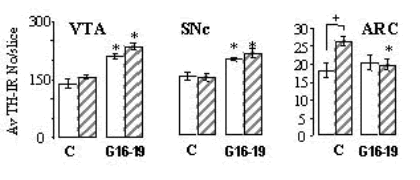| pA2 online © Copyright 2004 The British Pharmacological Society |
016P
University of Newcastle Winter Meeting December 2004 |
Brief antenatal exposure to glucocorticoids permanently alters dopaminergic cell numbers Simon McArthur, Julia C.Buckingham, Glenda E. Gillies. Division of Neuroscience & Psychological Medicine, Imperial College Faculty of Medicine, Du Cane Road, London W12 0NN. |
|
Evidence from human and animal studies suggests that antenatal exposure to early adverse environments disrupts development of mid-brain dopaminergic (DA) neurones and predisposes the individual to pathophysiological changes in central DA function that may lead to altered behavioural, emotional and cognitive processes throughout life (Weinstock, 2001). It is thus important to understand the mechanisms that underlie this neurobiological ‘programming’. Therefore, this study aimed to test the hypothesis that inappropriate exposure to glucocorticoid (GC) hormones at critical stages of development results in lifelong derangement of mid-brain dopaminergic (DA) systems.
Using our recently developed method for non-invasive exposure to GCs (Theogaraj et al., 2001), dexamethasone (0.5 µg/ml) was included in the drinking water of time-mated pregnant Sprague-Dawley rats between gestational days 16-19 and control animals received normal drinking water (n=8). At 70 days of age the brains were removed from male and female offspring and processed for tyrosine hydroxylase (TH) immunocytochemistry. TH positive (TH+) cell numbers in the substantia nigra pars compacta (SNc) and ventral tegmental area (VTA) were counted; similar measurements in the arcuate nucleus of the hypothalamus (ARC) were performed in order to determine the specificity of responses.

Effects of dexamethasone added to mother's drinking water on gestional days (G) 16-18 (0.5 µm/ml on THimmunoactive cell number (TH-IR No) in the VTA, SNc and ARC of adult male (![]() ) and female (
) and female (![]() ) offspring. *p<0.025 vs control (C), +p<0.025vs male (ANOVA with post hoc unpaired t Student's test). Data ara mean +/- sem=8.
) offspring. *p<0.025 vs control (C), +p<0.025vs male (ANOVA with post hoc unpaired t Student's test). Data ara mean +/- sem=8.
Our results (Figure 1) show that antenatal GC exposure increases TH+ cell numbers similarly in males and females in the VTA and SNc. In contrast to the mesencephalic populations, TH+ cell numbers in the ARC were significantly greater in control females compared with males, and neonatal exposure to dexamethasone abolished these sex differences by reducing cell numbers in the female, while having no effect in males. These results are the first to reveal a differential responsiveness of mid-brain and hypothalamic DA populations to the organisational actions of GCs. They also demonstrate a gender specific susceptibility of the hypothalamic populations to GC programming. Together, our data demonstrate that inappropriate exposure to GCs may play a key role in the neurobiological programming of central DA systems that have the potential to alter behavioural and endocrine responses throughout life, with possible implications for the development of pathophysiological changes in the whole animal.
Theogaraj E. et al. (2001). Experimental Lung Research 27, P6.
Weinstock, M. (2001) Prog Neurobiol 65, 427-51.
This work was supported by the Wellcome Trust, the Medical Research Council UK and Hammersmith Hospitals Research Trust.